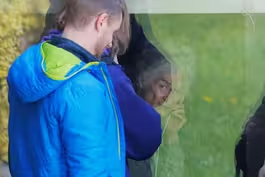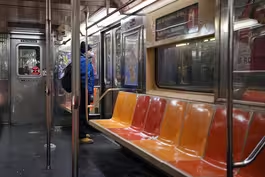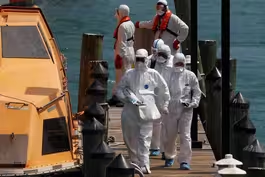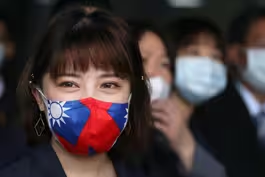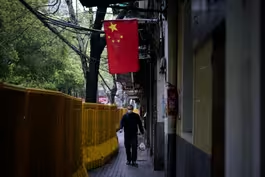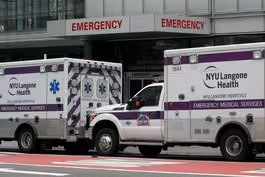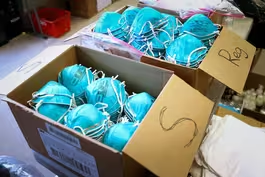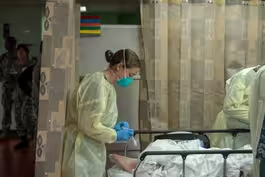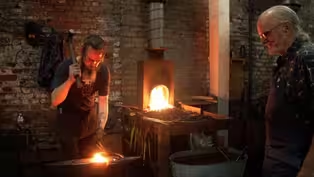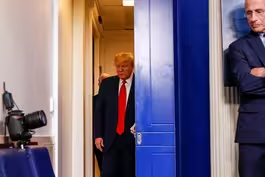
April 1, 2020 - PBS NewsHour full episode
4/1/2020 | 56m 26sVideo has Closed Captions
April 1, 2020 - PBS NewsHour full episode
April 1, 2020 - PBS NewsHour full episode
Problems playing video? | Closed Captioning Feedback
Problems playing video? | Closed Captioning Feedback
Major corporate funding for the PBS News Hour is provided by BDO, BNSF, Consumer Cellular, American Cruise Lines, and Raymond James. Funding for the PBS NewsHour Weekend is provided by...

April 1, 2020 - PBS NewsHour full episode
4/1/2020 | 56m 26sVideo has Closed Captions
April 1, 2020 - PBS NewsHour full episode
Problems playing video? | Closed Captioning Feedback
How to Watch PBS News Hour
PBS News Hour is available to stream on pbs.org and the free PBS App, available on iPhone, Apple TV, Android TV, Android smartphones, Amazon Fire TV, Amazon Fire Tablet, Roku, Samsung Smart TV, and Vizio.
Providing Support for PBS.org
Learn Moreabout PBS online sponsorshipJUDY WOODRUFF: Good evening.
I'm Judy Woodruff.
On the "NewsHour" tonight: another dark milestone.
The U.S. death toll rises past 4,500, as top health officials warn the best-case scenario will mean hundreds of thousands die.
Then: the question of masks.
As medical experts send mixed signals on whether wearing a mask is needed, what we know so far about facial protection and the pandemic.
Plus: the pandemic abroad -- how Taiwan got it right, preparing early and urgently to meet the threat of COVID-19.
MICKY DU, Taiwan: When I first arrived home, there were like three or four text messages.
"Welcome back to Taiwan.
This is the CDC.
We're just checking to see if you're OK." JUDY WOODRUFF: All that and more on tonight's "PBS NewsHour."
(BREAK) JUDY WOODRUFF: The United States has more than 200,000 coronavirus infections as of tonight, with some 4,600 deaths.
That is a 50 percent increase over the past two days.
And the World Health Organization is warning that the global count will shortly top one million cases, with 50,000 deaths.
The pandemic is taking its greatest toll in New York and other hot spots.
John Yang begins our coverage.
JOHN YANG: As the coronavirus death toll in New York City nears 2,000 people, officials warned today that fatalities in the pandemic's epicenter will continue to rise.
New York Governor Andrew Cuomo said that should be a warning to all of America.
GOV.
ANDREW CUOMO (D-NY): I say to my fellow governors and elected officials all across this country, look at us today, see yourself tomorrow.
JOHN YANG: In New York Harbor, the U.S. Navy hospital ship the Comfort prepared to care for non-COVID-19 patients, in hopes of easing the strain on overwhelmed hospitals.
And in Florida, Governor Ron DeSantis today issued stay-at-home order, a step he had resisted for several days, even as cases in his state had risen.
Later, Governor Brian Kemp of Georgia, another holdout, said he would sign a stay-at-home order tomorrow.
Meanwhile, the Navy responded to the request from the commander of the USS Theodore Roosevelt, docked in Guam, to evacuate the aircraft carrier's 5,000-person crew to stem an onboard outbreak.
THOMAS MODLY, U.S. Assistant Secretary of the Navy: We cannot and will not remove all the sailors from the ship, and that's not what the commanding officer requested either, nor the medical team.
Our plan has always been to remove as much of crew as we can while maintaining for the ship's safety.
JOHN YANG: In Detroit, people lined up for a drive-through testing site.
The city is facing an uptick in cases, and officials say it's shaping up to be the country's next hot spot.
Mayor Mike Duggan: MIKE DUGGAN (D), Mayor of Detroit: Somebody brought the virus into this community early on.
It spread in this community before we knew what was happening, and the places in this country that are getting hit are the places that were infected first.
JOHN YANG: As that grim reality settles in, President Trump has begun preparing Americans for the worst.
At the White House yesterday, he said he has been on top of the issue from the start.
DONALD TRUMP, President of the United States: I knew everything.
I knew it could be horrible, and I knew it could be maybe good.
Don't forget, at that time, people didn't know that much about it, even the experts.
We were talking about it.
We didn't know where it was going.
JOHN YANG: But in late January: DONALD TRUMP: We have it totally under control.
It's one person coming in from China, and we have it under control.
It's going to be just fine.
JOHN YANG: The White House late yesterday published projections that suggest the virus will take the lives of at least 100,000 Americans in the coming months.
Already in Europe, there have been 30,000 deaths, in hard-hit Spain, empty streets in Madrid, save for a few pigeons.
A stoplight turns green, but there were no cars on the road.
The country has recorded more than 100,000 cases, including Fernando Simon, who is leading the country's response.
Today, he spoke from his home.
FERNANDO SIMON, Spanish Health Emergency Chief (through translator): Right now, we are not in the battle to see if we are or are not in the maximum infection point, because it appears that we are there and we are descending.
So now the battle is to make sure that our health system is able to guarantee the adequate cover for all of our patients in treatment.
JOHN YANG: Elsewhere in Europe, police tape surrounded an empty Moscow playground, Prague's riverbanks disinfected, London music arenas have turned into testing centers.
Also in London, this time-lapse video of a 4,000-bed hospital being built in just two weeks.
The Nightingale Hospital opened to the public today to help care for an influx of coronavirus patients.
Meanwhile, the Wimbledon tennis tournament, still four months away, joined the growing ranks of events called off due to the pandemic, the first time Wimbledon has been canceled since World War II.
But, in Italy, a glimmer of hope.
ROBERTO SPERANZA, Italian Minister of Health (through translator): We must not confuse the first positive signals that we are seeing in these hours with an all-clear signal.
Data and the statistical projections made by experts show that we are on the right path and that the drastic decisions we have adopted so far are starting to bear fruit.
JOHN YANG: Officials there say they will stay under a national lockdown until at least April 13.
For the "PBS NewsHour," I'm John Yang.
JUDY WOODRUFF: The rising tide of infections drove financial markets sharply lower today.
On Wall Street, the Dow Jones industrial average lost 973 points to close at 20943.
The Nasdaq fell 339 points, and the S&P 500 dropped nearly 115 points.
And now to a public official who has personally battled the disease, and is now trying to lead his city during this crisis.
I am joined by Miami Mayor Francis X. Suarez, recently out of a 19-day quarantine.
Mayor Suarez, thank you very much for joining us.
And we are very glad to see you recovered and come through this.
But I want to start by asking you about Governor DeSantis' decision or announcement today that he is finally joining, what, 30 other governors around the country in ordering a statewide stay-at-home in Florida.
Was this the right time, or did he wait too long?
FRANCIS X. SUAREZ (R), Mayor of Miami, Florida: Well, it definitely was time.
We had ordered a stay-at-home order in the city of Miami days ago, if not weeks ago, and we were the first city in Dade County to order a stay-at-home, the first city to order a curfew.
And so it was important and imperative that the governor do likewise.
I think, when it's all said and done, we're going to look back and we're going to ask ourselves, did we do everything we could do to prevent this virus from spreading in our communities?
And I think that has to be our guidepost right now.
The other concern I have is our airport, which brings in 20 million people, and where 50 million people come through our city.
JUDY WOODRUFF: Did you urge the governor during this time since your city issued stay-at-home from today, have you been urging the governor to do this?
FRANCIS X. SUAREZ: I have been in constant communication with the governor, and I let him know when we issued our stay-at-home order that we would welcome a statewide stay-at-home order as well.
And I think, at the time, you know, there were 20 counties that didn't have any cases, and five counties that had five cases or less.
But I think the issue is that we, again, have to do everything we can do, which is why we were the first city to cancel large events, to issue a stay-at-home order, to issue a curfew, because we have to do everything that we can to prevent the spread of this virus, including myself, who was the second person in Dade County that tested positive.
JUDY WOODRUFF: For sure.
Well, tell us about the situation in Miami City.
What is it looking like there with regard to the number of cases and how are being handled, their medical situation?
FRANCIS X. SUAREZ: We are sort of the epicenter of Florida.
We have the most cases in the entire state.
We are ramping up our ability to test.
We just opened a testing site yesterday.
We're testing several hundred people a day, which means most likely that our cases are going to continue to go up, and we don't believe we are anywhere near the apex.
I find it hard to believe I was only the second person positive in the entire county.
So there's probably hundreds, if not thousands of people that are going undiagnosed or that we don't know are positive.
And so we need to get control of exactly how many people are positive.
We have to do contact tracing to make sure that we can do, like we said, everything that we can to get -- to flatten this curve.
JUDY WOODRUFF: Do you have the people, the personnel, the supplies, the equipment that you need to deal with what's going on in your city?
FRANCIS X. SUAREZ: We were very fortunate.
Our fire chief identified this threat very early on during the time it was in Wuhan, right around the time of the Super Bowl.
We hosted the Super Bowl this year in early February.
And he started purchasing personal protective equipment back then, spent millions of dollars, even without getting the authorization.
And so we are well-stocked.
I have been in constant communication with the hospital system, our public hospital system, which is the fourth largest in the country.
I have been told or I am being told so far has sufficient beds, but as we have seen with Italy, as we have seen with Spain, as we have seen with New York, this run on hospital services can happen very, very quickly.
And so we are trying to add capacity to our hospital system by having -- as you were showing in some of the opening clips, by having portable beds available off-site in some of our parks.
JUDY WOODRUFF: And, at this point, tell us what effect it's having on the broader community, clearly, people staying at home, people in every occupation, job you can imagine.
There's no income.
How are you dealing with that?
FRANCIS X. SUAREZ: That's an enormous concern, especially since it's April 1.
It's the beginning to have the month.
And so I am of the opinion.
I have written the governor, and I will ask the president here in this show that we need to have mortgage and rent relief immediately.
There needs to be a suspension, whether it's 60 days, 90 days, of mortgage and rent payments.
People need to be able to have enough money to eat, and that's got to be the most important and essential thing that people use their money for.
We in the city allocated $2 million, a million to feed our elderly and a million to feed those below the poverty level.
But we're going to -- if we don't take dramatic steps to make sure that we alleviate some of the more significant financial burdens in people's lives, my fear is it could get apocalyptic.
JUDY WOODRUFF: Apocalyptic?
You really mean that?
FRANCIS X. SUAREZ: Yes, I mean, you have to understand that, in a city like Miami, we - - after nine days, you know, without power, when there's a hurricane, it gets -- it can get pretty apocalyptic.
People get pretty desperate when they don't have some of the basics.
And, for me, I think what's imperative is that residents get mortgage and rent relief immediately, so they can use the money they have, in conjunction with, of course, the unemployment benefits that they're get from the state and the federal government, to pay for the most basic necessities.
That is going to be what people are going to be focusing on.
I hope that we don't ever get to an apocalyptic-like scenario, obviously.
And we are doing everything in the city to prevent that from happening.
But that's what we have to be prepared for.
And we have to prepare ourselves in terms of the economic impact that this is having on people's lives.
JUDY WOODRUFF: Well, Mayor Francis Suarez of Miami City, we certainly wish you the best with all of that.
And we're so glad to see you doing better after going through the coronavirus.
Thank you very much.
FRANCIS X. SUAREZ: Thank you so much.
JUDY WOODRUFF: As you have been hearing, this is a tough time for many hospitals in larger cities and in smaller ones.
And there are growing concerns for rural areas as well.
The next few weeks are expected to be especially difficult, as workers are pressed, and there is serious concern over a lack of protective equipment.
William Brangham has the latest in our series of conversations with health care workers and officials on the front lines.
WILLIAM BRANGHAM: We get two perspectives on this now from two different medical centers around the country.
Dr. Phillip Coule is chief medical officer for Augusta University Health System in Georgia.
And Michael Dowling is president and CEO of Northwell Health in New York state.
Gentlemen, thank you both very much for being here.
I know you're both busy, trying to care for all the people coming through your doors.
And we appreciate you being here.
Michael Dowling, to you first.
We have all who are -- all of us who are not in New York are following what has been going on there, and we see how difficult it seems to be.
You run the biggest health care system in that state.
Could you just give us a sense, how are things there?
What are your ICUs like?
Are they full now?
MICHAEL J. DOWLING, President and CEO, Northwell Health: Yes, obviously, we're in the epicenter right now in New York.
So, it is hectic, extremely busy.
The numbers are pretty extraordinary.
In our health system alone right now, we have got about 2,500 positive patients, COVID-positive patients in our hospitals.
That grows every day by about 300.
So, life changes.
I mean, everything about a hospital, everything about the way you worked a month, a month-and-a-half ago is all different.
The hospitals are all working together.
We're collaborating, but we're managing and trying, obviously, to stay ahead of it, because we're in the midst of a major, major battle here with a very resilient competitor, the virus.
But my view is that we will persist here and, at the end of the day, we will make sure that we win in this battle against this virus, and that's the way -- that's the optimism you have got to have in a situation like this.
WILLIAM BRANGHAM: And, Dr. Coule, I understand, being in Georgia, you might be a little bit behind where New York is right now.
I understand that you have been doing an enormous amount of testing of patients and of people in the general population.
Can you give us a sense of how -- what the value of that testing is, what it allows you to do?
DR. PHILLIP COULE, Chief Medical Officer, Augusta University Health System: Sure.
So, we do have advantage of being later in this wave of patients that we expect from COVID-19.
We have a distinct advantage, being an academic medical center at Augusta University, where we were able to get ahead of the curve on testing.
And we have been testing quite some time, a very efficient telemedicine screening program, as well as a drive-up testing program, that has allowed us to identify those at risk and identify positive cases to help us stay ahead of this.
Other areas within Georgia, as you know, even rural areas, have been hit hard, particularly Albany, Georgia.
Some of those patients are being transferred to us.
And then some other rural areas where this appears to be hitting harder, those patients are coming the our facility.
But as of right now, we have a team that has helped us keep ahead of this thing.
WILLIAM BRANGHAM: And I'm curious, Dr. Coule, staying with you for a moment.
We know that lots of hospitals facing very, very sick patients have had to wrestle with these very wrenching decisions, that, in an era of limited capacity, a limited supply of things like ventilators, that people have to wrestle with, how do we decide who gets a scarce ventilator and who doesn't?
How do you think about those things?
How do you as a system debate those things?
DR. PHILLIP COULE: Sure.
So one of the principles of a disaster is triage, and you have to triage and make very difficult decisions about who is the greatest benefit for a ventilator.
For example, if you can predict that a very elderly patient is not going to survive, then perhaps, if you do have scarce resources, then you need to reallocate that resource.
Now, we're not to that point, and we're -- have the advantage of being able to have those discussions in the setting of the calm before the storm.
Others, unfortunately, have been thrown into making those very difficult decisions very early.
As it stands now, our medical center, we are counting the surplus of ventilators.
We are worried about it, but, right now, we're in good shape.
WILLIAM BRANGHAM: Michael Dowling, obviously, as the head of a much bigger system, I'm curious.
You have an enormous number of employees who are working with people on the front lines.
How is your staff, how are those front-line workers holding up?
How are they doing?
I understand some of your staff have already themselves become infected.
MICHAEL J. DOWLING: Yes, we have had quite a number of staff infected, both on the front lines, as well in as in the management staff.
But I have been out on the floors, and I have been out in the ICUs, and out meeting with staff.
And I can tell you that, when you're out there and you watch the dedication and the commitment of these staff, it is pretty extraordinary.
A key part of it, of course, is making sure that you have the supplies.
All of the debate in the national media about masks and gowns and gloves and ventilators gets people concerned, not only the providers, but also the public.
But when you're able to assure your employees that you have the masks, that you have the PPEs, personal protective equipment, that they don't have to worry about that, that one of your mainly foresight is to make sure the staff is safe and secure, that helps enormously.
WILLIAM BRANGHAM: Indeed.
Dr. Coule, we have been seeing governors, mayors, public health officials all across the country saying, we need everyone to stay inside.
If you're not an essential worker, please stay home, keep your distance from others.
I understand that that has been a particular challenge in rural areas around you, where people simply are not listening to those warnings.
DR. PHILLIP COULE: It has.
In fact, we were particularly concerned about our churches and houses of worship, and actually actively -- our pastoral staff actively reached out to them to encourage them to not hold in-person services.
Unfortunately, we do have some churches to the south of us that we either didn't reach or they didn't get the message, but they held in-person services despite that.
And we're now seeing the impact of that with outbreaks that are tied to those churches.
WILLIAM BRANGHAM: All right, you both are obviously doing incredibly important work, and we thank you both very much for being here, Dr. Phillip Coule and Michael Dowling.
Thank you both very, very much.
MICHAEL J. DOWLING: Thank you so much.
Thank you.
DR. PHILLIP COULE: Thank you for having me.
JUDY WOODRUFF: In the day's other news: There is word from U.S. intelligence that China vastly understated its own death toll in the pandemic.
Two senior U.S. officials tell the "NewsHour" that the true number of dead in Wuhan, where the outbreak began, could exceed 25,000.
That is roughly 10 times what Wuhan reported.
Beijing claims that about 3,300 people died from across all of China.
President Trump said this evening that those numbers seem to be -- quote -- "a little bit on the light side."
In Iran, President Hassan Rouhani accused the United States today of missing a historic opportunity to ease tensions during the pandemic.
He said Washington could have eased sanctions on Iran, where COVID-19 has infected some 48,000 people and killed 3,000.
HASSAN ROUHANI, Iranian President (through translator): This was a good time.
This was an opportunity for Americans to apologize for their wrong actions.
This was a human issue, and no one would have reproached them for backing off.
This was the best historic opportunity for the Americans to come back from the wrong path they have chosen and to tell the Iranian nation, just once, that we are not against the Iranian people.
JUDY WOODRUFF: U.S. Secretary of State Mike Pompeo denied on Tuesday that sanctions affect humanitarian aid to Iran.
But he didn't rule out easing the financial penalties.
Back in this country, West Virginia became the latest state to delay its presidential primary because of the coronavirus.
The May 12 vote was pushed back today to June 9.
Meanwhile, Democratic presidential candidate Bernie Sanders urged the state of Wisconsin to postpone its primary, which is set for next Tuesday.
A new report finds widespread sexual harassment in the federal government's work force.
The U.S. Commission on Civil Rights estimates that nearly one in seven federal employees experienced sexual harassment between 2016 and 2018.
The rate of women filing claims shot up over those years, with black women particularly at risk.
The Food and Drug Administration today told drugmakers to stop selling Zantac and similar heartburn medications.
They are all versions of a drug known as ranitidine, and the FDA says they may be tainted with a cancer-causing chemical.
Many companies have already removed the products from shelves.
And this is officially Census Day.
Traditionally, wherever you were living today is listed as your residence in the 2020 census.
So far, though, the COVID-19 pandemic has forced the Census Bureau to suspend door-to-door counting.
Officials say they still expect to finish by year's end.
Still to come on the "NewsHour": the shifting messages on masks from top health officials in the U.S.; an ugly symptom, racism against Asian Americans in the wake of the pandemic; to Taiwan, where health officials moved quickly and may have prevented disaster; plus, how Americans are adapting to a new and uncertain way of life.
A majority of the country is now being told to stay at home and to keep their distance from others to try and stop the spread of the coronavirus.
Now some in the public health community are wondering if the general public should also be wearing face masks.
William Brangham is back with a report on the growing debate.
WILLIAM BRANGHAM: Face masks are a critical protective shield for the medical workers who are caring for the sickest COVID-19 patients.
This virus enters the body via tiny droplets through the eyes, nose, and mouth, so putting a barrier over the face can help stop infection.
In these wards, masks are meant to be worn every moment workers are exposed to the virus.
But what about the rest of us outside hospitals?
What about those of us who have to go to work around other people?
Should we be wearing masks?
What about people who, when they need to leave the house to go to the grocery store or the doctor, should they wear a mask then?
And if everyone did, would that change the course of this pandemic?
The government's advice about all of this may be changing.
Until just recently, the Centers for Disease Control and Prevention said, only health personnel and people confirmed to be sick with COVID-19 should be wearing masks.
And , similarly, that's what Dr. Anthony Fauci argued just a few weeks ago "on 60 Minutes."
DR. ANTHONY FAUCI, NIAID Director: Right now, people shouldn't be walk -- there's no reason to be walking around with a mask.
WILLIAM BRANGHAM: Even earlier this week, the U.S. surgeon general, Jerome Adams, said masks on the general population not only wouldn't help, but might hurt.
DR. JEROME ADAMS, Surgeon General of the United States: Wearing a mask improperly can actually increase your risk of getting disease.
It can also give you a false sense of security.
WILLIAM BRANGHAM: Dr. Leana Wen, an emergency physician at George Washington University and Baltimore's former public health director, agrees.
DR. LEANA WEN, Emergency Room Physician: There just isn't evidence that everyone wearing masks will prevent the transmission of coronavirus in our communities.
The recommendation is that people who are ill should be wearing masks, and certainly health care workers should be wearing masks.
But, everyday people, the recommendation is not that everyone should be going around wearing masks.
WILLIAM BRANGHAM: But that recommendation may be changing.
The head of the CDC said new evidence indicates that a significant percentage of people without symptoms may be unknowingly spreading the virus.
If they wore masks, perhaps even homemade, fabric ones, it's believed that transmission could be reduced.
Dr. Harlan Krumholz is a cardiologist and health care researcher at Yale University.
DR. HARLAN KRUMHOLZ, Professor of Medicine, Yale School of Medicine: There are plenty of people in society who are going to work every day, placing themselves at risk, in order to keep society going, in order to deliver packages, to provide groceries, to enable those vital services, policemen and firemen and firewomen and policewomen, all going out and doing their jobs, but placing themselves in positions where they're around others.
It's incumbent upon us to protect them.
They themselves need to be wearing masks and protective gear.
But we also need to be wearing masks to protect them.
WILLIAM BRANGHAM: N95 masks are considered the best, then surgical masks like these.
Right now, there aren't many rigorous studies comparing the effectiveness of surgical masks to handmade cloth ones.
But one thing we do know, right now, medical grade masks are in short supply nationwide.
Here's just one example.
Jennifer Radovich is a registered nurse at West Virginia University Medicine's Ruby Memorial Hospital, a hospital with a growing number of coronavirus cases.
Because her wing has no N95 masks left, Radovich turned to Facebook appealing for help.
JENNIFER RADOVICH, Ruby Memorial Hospital: I figured that would be the best way to reach the public, and just said, this is what we need.
I just kept sending messages out, saying, like, please help, we need these.
And I have had a great response.
WILLIAM BRANGHAM: Donated masks from individuals, local construction crews, even auto body shops, started coming in.
I have got to say, it just seems a little bit crazy that you, as a nurse, have to be calling construction crews and auto mechanics, trying to get masks to protect you in a hospital.
JENNIFER RADOVICH: Right.
Amazon has been sold out of them for weeks.
And they have - - I have even seen them on eBay.
I have seen a box of 24 as high as $699, with 24 bids on it.
WILLIAM BRANGHAM: Wow.
JENNIFER RADOVICH: So, yes, this is a real problem.
WILLIAM BRANGHAM: Dr. Leana Wen argues, if public health officials start recommending that the general population starts wearing masks, these shortages will get much worse.
DR. LEANA WEN: The last thing that we would want is for individuals to buy masks, hoard masks, and really make it even more challenging for our health care workers, who are going to be infected themselves, and then infect other people as a result.
There may come a time when widespread mask usage in the U.S. makes sense.
But that time is not now, because that time also requires for our country to be at the point where we can begin to loosen restrictions on social distancing, and when we have plenty of supply of masks and other equipment for health care workers.
We are not there for either of these two milestones.
GOV.
KIM REYNOLDS (R-IA): If you can sew, we need your time and talent to produce fabric face masks to protect Iowa's front-line workers.
WILLIAM BRANGHAM: But in the meantime, public officials and private citizens alike, from fashion designers to boat sail makers, have been producing masks of all kinds to try and address this national shortage.
Even without rock-solid evidence of their effectiveness, many argue a pandemic requires as many protections as possible.
DR. HARLAN KRUMHOLZ: So, there are a lot of questions about what mask do you need in what situation and how much protection do they confer?
The idea is that some barrier is better than nothing.
Do you need evidence beyond a shadow of a doubt that it's effective before people start wearing them?
Or do we say that, in this moment of time, it's prudent to do so?
And I favor the idea that we should.
WILLIAM BRANGHAM: And just in the last two days, the CDC director, Robert Redfield, the U.S. surgeon general, Jerome Adams, and Anthony Fauci all signaled a possible change in federal guidance about masks.
DR. ANTHONY FAUCI: When we get in a situation where we have enough masks, I believe there will be some very serious consideration about more broadening this recommendation.
DONALD TRUMP, President of the United States: We're making millions and millions of masks, but we want them to go to the hospitals.
WILLIAM BRANGHAM: President Trump has said mask manufacturers are working overtime, but, so far, he has not invoked his authority to order other companies to start making masks.
For the "PBS NewsHour," I'm William Brangham.
JUDY WOODRUFF: As reports of coronavirus have spread across the U.S., so have incidents of anti-Asian violence.
Amna Nawaz has more on that.
AMNA NAWAZ: The coronavirus' origin in China has caused a backlash against Asian-Americans in the first two months since the first positive diagnosis here.
From schoolyards, trips to the grocery store, some Asian-Americans have reported verbal and physical attacks.
And the FBI has warned of a potential surge in hate crimes still to come.
Beverly Liang told the "NewsHour" about her trip on the New York City subway.
BEVERLY LIANG, New York: He yelled at me on the train and said: "You people brought this virus here," before going to another part of the train car.
And I found that really unsettling.
My parents, me, my friends are all really on edge right now and kind of seeing how people react to us in public.
AMNA NAWAZ: Stories like Beverly's led to the creation of Stop AAPI Hate, an online hate crime reporting tool that has registered more than 1,000 incidents in less than two weeks.
Cynthia Choi is the co-executive director of Chinese for Affirmative Action.
She helped launch the reporting Web site, and she joins me now.
Cynthia, welcome to the "NewsHour," and thanks for being here.
What specifically are people telling you?
Included in some of the reports on your site, people will talk about being spat upon, about having things thrown at them.
I always like to mention, when we talk about race in America, we have to remember Asian-Americans are the most diverse racial group, right?
So, you're talking about dozens and dozens of different kinds of identities and ethnicities all under this one umbrella group.
And one of the most fascinating things about your report, I found, was that 61 percent of all reports were from non-Chinese people.
Did that surprise you?
CYNTHIA CHOI, Co-Executive Director, Chinese for Affirmative Action: Yes and no.
Obviously, the target has been Chinese, and the assumption that those who are being victimized are of Chinese descent.
But our report shows that it's affecting and impacting all Asian-Americans, and for the simple fact that there might not be a recognition of distinctions, but the fact that it's the Asian face, it's the perception that we're foreigners and that, again, we're all hosts of this infectious disease.
And that's what's so troubling about it.
AMNA NAWAZ: Now, Cynthia, I talked to leaders earlier in the month in the Chinese-American community in San Francisco, and I remember them telling me that they didn't want to report any of these kinds of discriminatory or racist attacks because they didn't want to rock the boat.
I wonder if you're worried that these numbers are you're seeing right now are actually lower than what's really happening on the ground?
CYNTHIA CHOI: Absolutely.
This is just the tip of the iceberg in terms of what's actually happening on a daily basis, and that we need to do better, I think, to reach those impacted populations, especially those that are less likely to report incidents to various agencies and are hesitant to report to law enforcement because of negative experiences or the feeling that nothing can be done about these incidents of hate.
AMNA NAWAZ: Cynthia, I have got to ask you about some of the rhetoric coming from the highest office in the land.
President Trump himself has publicly referred to the virus, linking it to China, despite that health experts here and across the world have said that that kind of rhetoric is dangerous.
I want to play for you really quickly his remarks from a recent briefing.
This was on March 26.
DONALD TRUMP, President of the United States: I talk about the Chinese virus.
And I mean it.
That's where it came from.
You know, if you look at Ebola, if you look at all -- or Lyme, right, Lyme, Connecticut, you look at all these different horrible diseases, they seem to come with a name, with a location.
And this was a Chinese virus.
But I don't have to say it, if they feel so strongly about it.
We will see.
AMNA NAWAZ: Cynthia, when you see the reports people are submitting to your online reporting tool, is there a way to link that kind of rhetoric to what people are experiencing?
CYNTHIA CHOI: Well, we think that his insistence in the past in using or referencing the Chinese virus or other administration officials referring to it as the Wuhan virus certainly exacerbates the situation.
And we know from our firsthand accounts on this tracker that we have individual who are mimicking the president's words, parroting them, I should say, and that they're also individuals who've reported their interactions of defending the president's words.
AMNA NAWAZ: Cynthia, I should mention just this afternoon former presidential candidate Andrew Yang published an op-ed talking about the fact that, despite the fact that 17 percent of America's doctors are of Asian descent, are on the front lines of fighting this right now, people are scared and they need someone to blame.
That fear is not going away anytime soon.
We know the pandemic will be something we're dealing with for a while.
I'm wondering if you're worried about the long-term effects of this, how you think this kind of fear and the blame that people feel they need to assign will play out over the months and the years ahead?
CYNTHIA CHOI: That's a really great question.
One thing that I do want to point out is that, throughout U.S. history, whenever there is a public health crisis or, in wartime, different groups can be scapegoated and blamed.
And, certainly, that's been the experience of Asian-Americans, Muslims, African-Americans.
The Latinx community have been subjected to that.
And we do believe that long after we can resume normalcy, and we beat the virus, we are very, very concerned in the Asian-American community that this will have a lasting impact.
We have yet to understand the full extent of what it will mean to come out on the other side.
We don't think that the anti-Asian sentiment that we're seeing now is going to go away, and we're going to need to address that as a society.
AMNA NAWAZ: We will, indeed.
That is Cynthia Choi, the executive director of Chinese for Affirmative Action, joining us tonight.
Thank you.
JUDY WOODRUFF: We look now at a COVID-19 success story.
Taiwan is just off the coast of mainland China.
Millions travel between Taiwan and the Chinese mainland.
Johns Hopkins University had predicted Taiwan would have the second most COVID-19 cases in the world.
But, today, there are 80 countries and territories with more than Taiwan's 329 cases.
Nick Schifrin follows a Taiwanese woman going home to figure out how they did it.
ANNA LEE, Taiwan: I am currently at the Gatwick Airport in London.
NICK SCHIFRIN: When 28-year-old Anna Lee left her boyfriend to fly home to Taiwan last week, she took no chances.
Why are you wearing the mask and gloves and goggles?
ANNA LEE: I'm trying to avoid any contact to air.
NICK SCHIFRIN: Lee didn't feel safe in Britain, where the airports are empty and the prime minister was criticized for a slow initial response.
ANNA LEE: If he is not even helping his own citizens, why would he help a foreigner like me?
I thought, all right, I would go back to Taiwan for now.
Everyone is very careful.
NICK SCHIFRIN: So careful, Lee found fellow Taiwanese Jason Yang waiting for his flight to Taipei in a body suit bought off eBay.
MAN (through translator): I believe that, in England, it's already lost control.
And if I go back to Taiwan, I will be taken care of.
NICK SCHIFRIN: Taiwan is only 80 miles off the coast of mainland China.
When Johns Hopkins modeled COVID-19, it predicted Taiwan would have the second highest number of cases.
That prediction didn't become reality.
Taiwan has succeeded at containing COVID-19 starting at arrival.
ANNA LEE: we are getting off the plane.
NICK SCHIFRIN: Lee Skyped with us during her hour-long journey through the Taipei Airport.
The first step Taiwan took was identifying possible cases.
ANNA LEE: They gave me this form to fill out my temperature in the next 14 days.
NICK SCHIFRIN: Lee told authorities she'd had a cough in the last two weeks, so security escorted her to secondary screening.
She had her temperature taken, like this woman, and she filled out forms consenting to new regulations and providing recent medical history.
ANNA LEE: My temperature that they just took, and it was asking what symptoms I had, and if I went to doctor.
NICK SCHIFRIN: And she got a COVID-19 test at the airport.
Taiwan uploads these results into its national health care database to create a kind of coronavirus database that everyone has to enroll in.
ANNA LEE: We have to register first online.
They will send me a text message.
I have to show them the text message before we can pass here.
NICK SCHIFRIN: But that's where government tracking begins.
After her bags are disinfected, her ride home is in a government-provided taxi by herself.
The three-hour drive costs 80 bucks.
ANNA LEE: Now I cannot take any public transportation, so I had to use this contract taxi.
NICK SCHIFRIN: Lee headed home, knowing the government would stay in touch during a mandatory two-week quarantine.
MICKY DU, Taiwan: Welcome to my humble house.
NICK SCHIFRIN: The government has also stayed in touch with Micky Du, who arrived from Australia on March 22.
MICKY DU: Well, the first day, they immediately phoned me, almost within the hour that I go home, OK?
And there were actually several text messages.
When I first arrived home, there were like three or four text messages.
"Welcome back to Taiwan.
This is the CDC.
We're just checking to see if you're OK." NICK SCHIFRIN: Micky's girlfriend recorded him in his apartment.
Everyone who arrives in Taiwan today is tracked by cell phone to make sure they stay at home.
Taiwan's Center for Disease Control tries to make 14-day quarantines easy.
MICKY DU: She asked me whether or not I lived at this address.
And, yes, sure, that is my address.
And I said, "When are you going to be here?"
She said, "I'm going to be there in five minutes."
I'm like, oh, OK. And no (EXPLETIVE DELETED) they showed up in four minutes.
(LAUGHTER) MICKY DU: They were, like, outside.
So she just gave me a packet of masks, and there were 14 masks in the packet exactly.
NICK SCHIFRIN: Taiwan was able to take all of these steps because it learned lessons the hard way.
DR. STEVE KUO, Former Director-General, Taiwan Center for Disease Control: The SARS outbreak is a wakeup call for Taiwan.
And we learn a lot from the SARS outbreak.
NICK SCHIFRIN: Dr. Steve Kuo is the former head of Taiwan's CDC, and led the SARS task force in 2003, when the SARS epidemic made hundreds of Taiwanese sick and killed more than 70, the third highest tally in the world.
The very next year, authorities prepared for the next crisis.
That preparation allowed Taiwan's CDC to detect the COVID-19 threat before the Chinese government announced it.
DR. STEVE KUO: We pick up the signal that there is some strange outbreak in the Wuhan areas at the end of the last year from social media networks.
We decided, and we did send two medical doctors to Wuhan from Taiwan CDC to get a better understanding of what happened there, OK?
And then five days later, on January 20, the government decided immediately to set up and activate the central command centers.
NICK SCHIFRIN: That centralized command center launched border restrictions before almost anyone else, set local quarantine rules, and turned to technology.
One phone app allows Taiwan residents to find stores with masks in stock.
Another app provides information on all of those who are COVID-19 positive, where they have been, and their case history.
And the government made sure it had enough medical equipment.
DR. STEVE KUO: After the SARS outbreak, actually, we have the law to require hospitals to have a stockpile for all medical supplies for 30 days for the hospitals.
NICK SCHIFRIN: Another reason Taiwan acted so early, they didn't trust either the Chinese government or the head of the World Health Organization, who, in January, praised China's response, says Bill Stanton, the former top U.S. diplomat in Taipei.
WILLIAM STANTON, Former Top U.S.
Diplomat in Taipei, Taiwan: He was just defending the Chinese position and echoing what they had to say.
And it made the Taiwanese even more suspicious to what the Chinese were doing for that reason.
China doesn't allow Taiwan into the WHO, and that's really stupid, because Taiwan is one of the main countries in the world that has expertise on international health issues.
NICK SCHIFRIN: For Anna Lee, that expertise translates into trust in her government.
ANNA LEE: I feel like, even if there is something wrong with my body, I will be taken care of, which is quite promising.
And I'm quite happy with how the government take it very seriously.
That's why we keep the cases very low.
NICK SCHIFRIN: Which means, for Anna Lee and many Taiwanese who are quarantined today, there's no place like home.
For the "PBS NewsHour," I'm Nick Schifrin.
JUDY WOODRUFF: Today, Taiwan announced that it would donate 10 million masks to medical workers around the world, two million to the U.S. President Trump has been in the White House Briefing Room again this evening, along with other administration officials, for what has become a regular discussion of the COVID-19 response.
And our Yamiche Alcindor joins us now with the latest.
Yamiche, hello.
We know so much of the focus today has been on those grim projections from the president, from the White House yesterday about the number of deaths, the number of cases.
What are you learning about how that is affecting the White House' thinking overall?
YAMICHE ALCINDOR: (AUDIO GAP) White House continues to be the fact that more than 100,000 Americans could die from the coronavirus even in the best-case scenario.
So President Trump today was talking about those numbers, and Vice President Pence made it very clear the White House was studying models.
And, on last Friday, they decided to finalize those numbers, present them to the president.
On Saturday, when the president actually learned of these numbers -- that's what the White House is saying -- he was moved by this, and that's why he went from saying that the country could be possibly easing up guidelines by Easter Sunday to saying, no, we're going to have to keep the guidelines in place until April 30.
I want to put up this graph for people.
This is a graph that the White House was using yesterday as they were describing -- and it's one that they have continued to go back to today.
If you look at this dark hill, the dark blue hill, what you see is 1.5 to 2.2 million Americans could die if there was no intervention, if there was no social distancing.
That's what the White House's worst-case scenario is.
Then, if you look at the other hill, it's a smaller bump, it's says that 100,000 to 240,000 Americans could die.
Those are the numbers that we should be focused on today.
That's the graph at the heart -- the graph, rather, at the heart of the White House's numbers.
The president also made it clear that a lot of these deaths are going to be happening within the next month.
And the important thing to note here is that the governor of New York, who is, at this point, the hardest-hit state, he said that, in his models, about 16,000 people will die in New York.
That means 93,000 other people, he said, could be dying on other states and - - in other states.
So what we see there is that this is obviously a big issue in New York, but he's saying that the deaths might be nationwide, so we should really be looking at this as we go forward.
JUDY WOODRUFF: So grim, so -- still so hard to comprehend those numbers.
And so, Yamiche, you have been in the briefing.
What more can you tell us about what the White House is saying today?
YAMICHE ALCINDOR: Well, Judy, it was a really different White House briefing than we have seen in the past.
Today, the president began with talking about national security.
And he said -- and he said specifically that he wanted to talk about anti-drug operations.
And he said that the Navy is going to be beefing up operations in the Pacific Sea, as well as -- in the Pacific Ocean, I should say, rather, and the Caribbean Sea.
And they're going to be fully focusing on cartels, they say, that are trying to use the coronavirus outbreak to smuggle more drugs into America.
Here's what the president said about that: DONALD TRUMP, President of the United States: Well, for a long time, we have had a lot of drugs coming into our country.
And it's not that it's increased.
It's probably -- we have probably got it down a little bit, but it's still a tremendous number.
And families are being ruined.
Lives are being ruined.
It's an incredible thing, especially as you're at this position.
You would never believe it.
I see things that nobody would believe.
I see reports that nobody would believe.
So I met with the group behind me, all of them.
And we said, what do you think we can do?
And they think they can interdict.
They think that we can stop it before it gets to the shores.
YAMICHE ALCINDOR: So, today, the president brought out national security officials.
He brought out the national security adviser.
He brought out Attorney General William Barr.
He brought out people like the Joint Chiefs of Staff.
These are people that we usually do not see at the Coronavirus Task Force Briefing.
We usually see the top scientists talking.
But he waited until the second half of the briefing to have the scientist speak.
And he wanted to underscore that he thinks that this narcotics appropriations that he's having, that they are really the top priority, at least today, even though, of course, we're looking at those grim numbers when it comes to the coronavirus outbreak.
So that's a really important point that President Trump was trying to make.
Now, I should say that this comes with the context that there was a Naval ship that was asking -- a commander was asking that sailors be evacuated from that ship.
It was docked in Guam.
John Yang, of course, had that in the script.
And he was talking about it at the beginning of the show.
And what you see there is the president basically having this context, saying that there needs to be this anti-drug activity.
The other thing I should note, really quickly, is that Adam Schiff, a prominent member of the House, says that, after the coronavirus bill phase four is done, after more relief is given, he wants to see some sort of commission to really look at the White House's handling of the coronavirus outbreak.
So, we should be looking out for that as well.
JUDY WOODRUFF: For sure.
Yamiche Alcindor monitoring it all at the White House, thank you, Yamiche.
And now a look at how the coronavirus pandemic has forced people, in a way, to change how they interact with each other, and seek out new ways to connect and to celebrate.
Lisa Desjardins has the story.
LISA DESJARDINS: When Berklee Sousa turned 12 last month, a birthday party was out of the question.
Her state, California, was under a shelter-in-place order.
HOLLY SOUSA, Mother: She's a kid.
She doesn't understand.
There was a lot of, I hate everything, and why did it have to be in March, and crying.
And she was really just bummed.
So we wanted to surprise her with something.
LISA DESJARDINS: So, instead of a party, her mom, Holly, organized a birthday parade.
One after another filled with friends and family drove by her Bakersfield home.
One even had a special delivery for her: a cake.
HOLLY SOUSA: Thank you, Chelsea.
BERKLEE SOUSA, 12 Years Old: Just to wake up, and then come out front and see all the people come by was really cool, like a really cool experience.
And it made me feel a lot better about my birthday.
LISA DESJARDINS: Across the country, parades have also become tools for teachers trying to stay in touch with students while school is closed.
They ride in a caravan and wave to families lining the streets.
Families are finding new ways to connect with each other as well.
Grandfather Dave Schnieders (ph) of Indianapolis visited his 1-year-old grandson, David Drew, through a living room window.
Nursing homes are off-limits for most outsiders, so in Middletown, Ohio, Charlie Adams used a bucket truck to visit his 80-year-old mother on the third floor.
DERRICK "D-NICE" JONES, Celebrity Deejay: Make sure you wash your hands.
LISA DESJARDINS: People are reinventing partying, too.
Deejay D-Nice has been spinning records live for people to dance at home, just him, great music and the occasional hat change, sometimes nine hours straight.
One virtual party of his drew over 100,000 people, including celebrities.
DERRICK "D-NICE": Michelle Obama is in here.
Oh, my gosh.
Let's go.
We are partying right now.
LISA DESJARDINS: On a smaller scale, people are taking their talents to their front porches.
Here's a recent classical violin performance for passersby in a Washington, D.C., neighborhood.
In Saratoga Springs, Utah, Heather Doney taught a Zumba class for her neighbors from her backyard.
HEATHER DONEY, Utah: There's something about that endorphin rush that you get when you dance, and I think everybody can relate to that.
Even if you feel like you can't dance, there's just something about moving that sends those happy endorphins out.
And so it's been such a blessing to be able to move again.
LISA DESJARDINS: When we will all be able to move around freely again remains an open question, but for newly turned 12-year-old Berklee Sousa, she's already learned a powerful lesson.
BERKLEE SOUSA: Even though there's a lot of things going on right now in the world, you can still do something to make it better.
Not everything can be negative about everything that's going on, and to just stay positive during this.
LISA DESJARDINS: For the "PBS NewsHour" in Washington, I'm Lisa Desjardins.
JUDY WOODRUFF: And that is the "NewsHour" for tonight.
I'm Judy Woodruff.
Join us online and again here tomorrow evening.
For all of us at the "PBS NewsHour," thank you, stay safe, have some fun, and we'll see you soon.
Amid isolation, these Americans have found ways to connect
Video has Closed Captions
Clip: 4/1/2020 | 3m 22s | Despite social isolation, these Americans have found new ways to connect (3m 22s)
Asian Americans report rise in racist attacks amid pandemic
Video has Closed Captions
Clip: 4/1/2020 | 6m 36s | Asian Americans report rise in racist attacks amid pandemic (6m 36s)
How Miami mayor hopes to avoid an 'apocalyptic' scenario
Video has Closed Captions
Clip: 4/1/2020 | 6m 32s | How Miami Mayor Francis Suarez hopes to avoid an 'apocalyptic' scenario (6m 32s)
How Taiwan has become a COVID-19 success story
Video has Closed Captions
Clip: 4/1/2020 | 7m 15s | Taiwan's aggressive efforts are paying off in fight against COVID-19 (7m 15s)
News Wrap: U.S. believes China vastly understated death toll
Video has Closed Captions
Clip: 4/1/2020 | 3m 26s | News Wrap: U.S. believes China vastly understated its COVID-19 death toll (3m 26s)
New York's Gov. Cuomo warns other states of what's to come
Video has Closed Captions
Clip: 4/1/2020 | 4m 55s | As New York's death toll approaches 2,000, Cuomo warns other states of what's to come (4m 55s)
Should everyone wear a mask to protect against COVID-19?
Video has Closed Captions
Clip: 4/1/2020 | 7m | Should everyone be wearing a mask to protect against coronavirus? (7m)
Strategies from hospitals on front lines of COVID-19 fight
Video has Closed Captions
Clip: 4/1/2020 | 7m 19s | Strategies from hospitals on the front lines of the COVID-19 fight (7m 19s)
This unusual Charleston college produces educated artisans
Clip: 4/1/2020 | 7m 19s | This unusual Charleston college produces educated artisans (7m 19s)
Trump briefing focuses on national security and data models
Video has Closed Captions
Clip: 4/1/2020 | 5m 2s | Trump puts focus on national security and data models amid coronavirus outbreak (5m 2s)
Providing Support for PBS.org
Learn Moreabout PBS online sponsorshipSupport for PBS provided by:
Major corporate funding for the PBS News Hour is provided by BDO, BNSF, Consumer Cellular, American Cruise Lines, and Raymond James. Funding for the PBS NewsHour Weekend is provided by...
